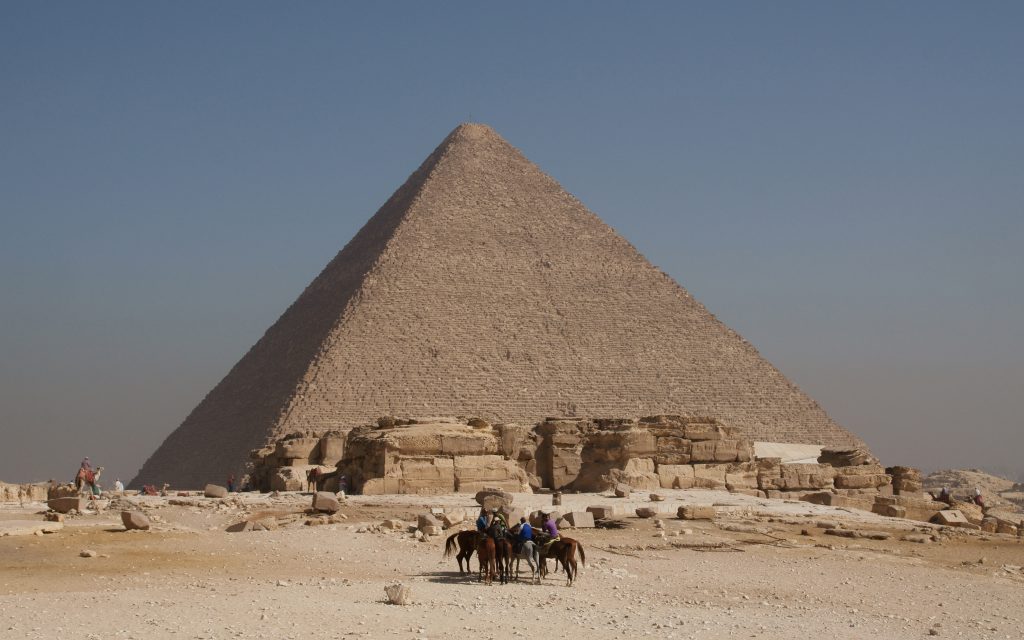The construction of the Great Pyramid of Giza has been a great mystery for many centuries. Recently, archaeologists believe that they have found evidence that suggests that it was not slaves, under the order of King Khufu, who were responsible for building the pyramid. With the discovery of nearby mastabas, there is now substantial evidence suggesting that normal villagers would periodically help construct the Great Pyramid, and they were motivated by their religious beliefs.1
King Khufu is considered one of the greatest rulers of his time, largely due to the elaborate pyramid he was able to create during his lifetime. He was known as a cruel and tyrannical leader, but was evidently powerful by being able to gather a large workforce and enough materials to construct the Great Pyramid, most of which is still intact today. According to Greek historian Herodotus, there had been around one hundred thousand slaves working through King Khufu’s reign. This was proved false in 1990 when the archaeologist Zahi Hawass discovered a town of mastabas near Giza.

These mastabas were rectangular mounds made of mud bricks. Eventually, they would stack some of them together to form pyramids, giving them the idea of the modern pyramid. The findings of many mastabas suggests that the workers were not slaves but were actually compensated in some form for their labor. They also discovered two miniature pyramids that held the remains of officials, such as supervisors, technicians, and craftsmen on the upper level, and other laborers on the lower level.2 The workforce consisted mainly of peasant farmers who would work during the fall and winter seasons. During that time period they were unable to work on their farms due to the seasonal overflow of the Nile River. This gave them an opportunity to continue working throughout the year. It was also a great way for the peasant farmers to get food, clothing, and shelter.3 Some laborers took part in a group called a phyle, which was a rotating group of workers who would work for a month. The king would collect surplus crops as well as other clothing to distribute to these workers, which he levied as a form of tax. Egyptologist such as Zahi Hawass and Mark Lehner now estimate that only about twenty to thirty thousand men were needed to build the Great Pyramid.
The construction of the pyramid was a communal project in which all Egyptians took part, including women as well as men. At the time, there were no machines or animals to help carry the loads of limestone and granite to the pyramids.4 Every block was handmade and crafted to fit perfectly alongside the other pieces. They cared greatly in their work and took pride in their accomplishments. Not only were they building the burial site for their king, but they were also taking part in the construction of a new and elaborate Egypt.
During Egypt’s Old Kingdom, when these pyramids were built, the kings were associated religiously to gods. They were seen as the living manifestation of the god Horus, the god of the sky. The god Horus was also the son of Osiris, who was the king of the underworld. Once the king would pass away he would become one with Horus.5 This helped motivate the laborers to continue building the pyramids. Most Egyptians at that time were very religious and spent their life preparing for what would come after death. They believed that by building the pyramid for their king, a descendant of Osiris, they would assure both their king and themselves a good afterlife. Because of this, they did not see their work as a continuous strain, but rather viewed it as an honor.
Overall, it was a very organized and coherent system that allowed everyone to partake in. It was beneficial not only to King Khufu, but to the entire Egyptian society as well. Jobs were created and many peasants received benefits of clothing and shelter from the enterprise. It united the Egyptian civilization and created magnificent pyramids that we can still visit today.
- Mastabas are burial mounds that were used to bury rulers and pharaohs, which later gave way to the idea of a pyramid. See Global Events : Milestone Events throughout History, Vol 1. Africa, Jennifer Stock, ed. (Detroit : Gale, Cengage Learning, 2014., 2014), 12. ↵
- Global Events : Milestone Events throughout History, Vol 1. Africa, Jennifer Stock, ed. (Detroit : Gale, Cengage Learning, 2014., 2014), 18. ↵
- The Oxford Companion to Archaeology (2 ed.), 2012, s.v. “Pyramids of Giza,” by Edward Bleiberg. ↵
- The Oxford Companion to Archaeology (2 ed.), 2012, s.v. “Pyramids of Giza,” by Edward Bleiberg. ↵
- Funk & Wagnalls New World Encyclopedia, 2016, s.v. “Horus”. ↵



87 comments
Hector Garcia
Through time, I believe that we are able to lose translation of events that happened in the past. And I think this article is a perfect example of it. It is interesting to see evidence that challenged the ideas we thought of the Egyptians. Overall, the story of who built the Great Pyramid of Giza was very descriptive. The article was able to give an idea of what a life as mastabas was in the Old Kingdom.
Belia Camarena
Great job writing this article! It was very informative, and I enjoyed reading about how the pyramids were constructed. I am glad that this alternative method of building has been discovered; this means that the Egyptian’s main labor force was citizens, not slaves. Although the King was harsh, he did help his citizens by providing compensation for this massive building project.
Joshua Castro
This was such a captivating topic to read about! I was not aware that this was how the pyramids were constructed. I had always believed them to have been constructed by slaves, but I found it even more astonishing that it was the entire public as a whole! It’s amazing what people are capable of when they all come together to work towards a common goal; even without fancy tools or devices! This was an extremely fascinating article.
Maria Mancha
The article was extremely fascinating. I had also thought the Pyramid of Giza was made my slaves because that is what I had learned. However I learned that it was made by the common people who actually took pride into making it. It was really interesting to learn that the King was supposed to become one when he died with Horus which is the son of the King of the Underworld. It was cool to see how their belief played a role into building the pyramid. Overall I really enjoyed this article.
Anais Del Rio
This was really interesting to read especially the fact that the pyramids were most likely built by loyal local people. I think many people believed that slaves had built the pyramids as punishment for the crimes they did. But it does make sense that it was seen as a religious task because the pyramids were so tall as a way for their deceased pharaohs to ascend near the gods.
Isaac Rodriguez
Before reading the article I thought that the Pyramid of Giza was built by slaves. Considering its immense size, It surprises me that it took only around 20 years to build. I can imagine the difficulty of carrying large heavy bricks up hundreds of feet and ensuring that they are stacked in a specific order to form a perfect pyramid.
Grady Purcell
This article is very entertaining to read and contains a lot of details I didn’t know about on this subject. I always knew that these pyramids were built by humans and that the construction that was put towards making this happen is so crazy and mind blowing. These pyramids look like they were placed there by aliens or something just because of the enormous size of these things they truly astonish me and I still wonder how humans back then could have built something that massive.
Johnanthony Hernandez
Great article, the construction of the Great Pyramid has been something that has interested me for years. I’ve read about different ways that it could have been built but very few of the things that I’ve read discuss the purpose of why and who built it. While many think that slaves build it, I liked how you said that it was the Egyptian people who did. Few realize or know that they were the ones who built it.
Caroline Bush
Great article! I remember when I first heard about how the pyramids might not have been build by purely slaves but also citizens. It was a surprising fact but not that shocking. Its was interesting to see just how fearful the Egyptian citizens were of death and just how devoted they were to there pharaoh. I really enjoyed reading this article and appreciated the amount of details included in it. This was also a very interesting article about topic people may think they know everything about.
Anna Guaderrama
All I can really think after reading this is wow, I always though it was slaves forced against their will basically that built the pyramid. I never would have guessed that they WANTED and were happy to build the pyramid. It’s crazy to think about the extensive time period it must have took to finish completing the project, so I think it’s amazing that they kept their motivation for so long. And what’s even more impressive is to think about how it’s still in great condition after all these years.